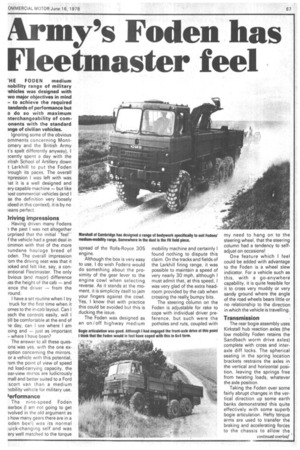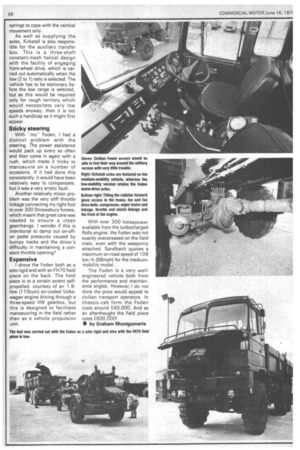Army's Fatten has Fleetmaster feel
Page 69

Page 70

If you've noticed an error in this article please click here to report it so we can fix it.
HE FODEN medium nobility range of military 'ehicles was designed with wo major objectives in mind to achieve the required tandards of performance but o do so with maximum Iterchangeability of comonents with the standard Inge of civilian vehicles.
Ignoring some of the obvious omments concerning Montornery and the British Army Vs spelt differently anyway), -I .icently spent a day with the ritish School of Artillery down t Larkhill to put the Foden 'rough its paces. The overall npression I was left with was let it is a well designed and ery capable machine — but like lost commercial vehicles (and I se the definition very loosely deed in this context), it is by no teens perfect.
)riving impressions Having driven many Fodens .1 the past I was not altogether urprised that the initial ''feel" f the vehicle had a great deal in ommon with that of the more lundane haulage breed of oden. The overall impression om the driving seat was that it mked and felt like, say, a conentional Fleetmaster. The only bvious (and major) difference /as the height of the cab — and ence the driver — from the round.
I have a set routine when I try truck for the first time when it omes to the in-cab layout. Can I aach the controls easily, will I till be comfortable at the end of le day, can I see where I am oing and — just as important where I have been?
The answer to all these quesons was yes, with the one exeption concerning the mirrors. or a vehicle with this potential, -om the point of view of speed nd load-carrying capacity, the ear-view mirros are ludicrously mall and better suited to a Ford scort van than a medium lobility vehicle for military use.
Performance The nine-speed Foden earbox (I am not going to get wolved in the old argument as ) how many gears there are in a oden box!) was its normal luick-changing self and was ery well matched to the torque
spread of the Rolls-Royce 305 engine.
Although the box is very easy to use, I do wish Fodens would do something about the proximity of the gear lever to the engine cowl when selecting reverse. As it stands at the moment, it is simplicity itself to jam your fingers against the cowl. Yes, I know that with practice this could be avoided but this is ducking the issue, The Foden was designed as an on/off highway medium
mobility machine and certainly I found nothing to dispute this claim. On the tracks and fields of the Larkhill firing range, it was possible to maintain a speed of very nearly 30 mph, although I must admit that, at this speed, I was very glad of the extra headroom provided by the cab when crossing the really. bumpy bits.
The steering column on the Foden is adjustable for rake to cope with individual driver preference, but such were the potholes and ruts, coupled with my need to hang on to the steering wheel, that the steering column had a tendency to selfadjust on occasions!
One feature which I feel could be added with advantage to the Foden is a wheel slew indicator. For a vehicle such as this, with a go-anywhere capability, it is quite feasible for it to cross very muddy or very sandy ground where the angle of the road wheels bears little or no relationship to the direction in which the vehicle is travelling.
Transmission
The rear bogie assembly uses Kirkstall hub reaction axles (the low mobility Foden retains the Sandbach worm drive axles) complete with cross and interaxle diff locks. The spherical seating in the spring location brackets restrains the axles in the vertical and horizontal position, leaving the springs free from twisting loads, whatever the axle position.
Taking the Foden over some fairly abrupt changes in the vertical direction up some earth banks demonstrated this quite effectively with some superb bogie articulation, Hefty 'torque arms are used to transfer the braking and accelerating forces to the chassis to allow the springs to cope with the vertical movement only.
As well as supplying the axles, Kirkstall is also responsible for the auxiliary transfer box. This is a three-shaft constant-mesh helical design with the facility of engaging front-wheel drive, which is carried out automatically when the low (2 to 1) ratio is selected. The vehicle has to be stationary before the low range is selected, but as this would be required only for rough territory which would necessitate very low speeds anyway, then it is not such a handicap as it might first appear.
Sticky steering With -myFoden, I had a distinct problem with the steering. The power assistance would pack up every so often and then come in again with a rush, which made it tricky to manoeuvre on a number of occasions. If it had done this consistently, it would have been relatively easy to compensate, but it was a very erratic fault.
Another relatively minor problem was the very stiff throttle linkage connecting my right foot to over 300 Shrewsbury horses, which meant that great care was needed to ensure a clean gearchange. I wonder if this is intentional to damp out on-offon pedal pressures caused by bumpy tracks and the driver's difficulty in maintaining a constant throttle opening?
Expensive
I drove the Foden both as a solo rigid and with an FH70 field piece on the back. The field piece is to a certain extent selfpropelled, courtesy of an 1.8litre (110cuin) air-cooled Volkswagen engine driving through a three-speed VW gearbox, but this is designed to facilitate manoeuvring in the field rather than as a vehicle propulsion unit. With over 300 horsepower available from the turbocharged Rolls engine, the Foden was not exactly overstressed on the field trials, even with the weaponry attached. Sandbach quotes a maximum on-road speed of 109 km/h (68mph) for the mediummobility model.
The Foden is a very wellengineered vehicle both from the performance and maintenance angles. However, I do not think the price would appeal to civilian transport operators. In chassis-cab form the Foden costs around £40,000. And as an afterthought the field piece costs £600,000!
by Graham Montgomarie
















































































































